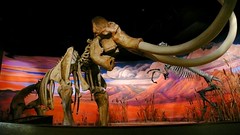
In his novel Jurassic Park, the late Michael Crichton thrilled us with the idea that reviving dinosaurs was a possibility. Although DNA sequencing (the process of determining the exact order of the chemical building blocks that make up DNA) was a very new technology at the time (the longest genome that had ever been sequenced was a virus), almost 20 years later, hundreds of animal genome sequences have been published. This week scientists have, for the first time, sequenced the genome of an extinct animal: the woolly mammoth:
Their groundbreaking achievement has them contemplating a once unimaginable future when certain prehistoric species might one day be resurrected. "It could be done. The question is, just because we might be able to do it one day, should we do it?" asked Stephan Schuster, the Penn State University biochemistry professor and co-author of the new research.
The million-dollar project is a first rough draft, detailing the more than 3 billion DNA building blocks of the mammoth, according to the study published in Thursday's journal Nature. It's about 80 percent finished. But that's enough to give scientists new clues on the timing of evolution and the deadly intricacies of extinction.
The project relied on mammoth hair found frozen in the Siberian permafrost, instead of bone, giving biologists a new method to dig into ancient DNA. Think of it as CSI Siberia, said Schuster.
It is a fair bet that a complete genome and closely related species would make it easier to pull a Crichton on a mammoth than on a dinosaur. But easier is far from easy. To put flesh on the bones of the draft sequence — to go from a genome to a living, breathing beast — would require you to master, at the very least, the following steps: defining exactly the sequence or sequences you want for your creatures; synthesizing a full set of chromosomes from these sequences; engulfing them in a nuclear envelope; transferring that nucleus into an egg that would support it; and getting that egg into a womb that would carry it to term. None of those steps is currently possible.



